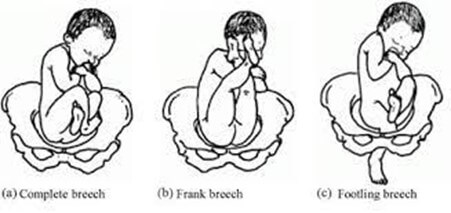Introduction
Introduction ( 5 Questions)
A nurse is caring for a client who is in labor and has a breech presentation.
The nurse knows that this client is at increased risk for which complication?
Placenta previa is a condition where the placenta covers the opening of the cervix, not the baby’s position. Placenta previa can cause bleeding during pregnancy and labor, but it is not directly related to breech presentation.
A cord prolapse occurs when the umbilical cord slips through the cervix and into the vagina before the baby during labor.
This can cause the cord to become compressed or twisted, cutting off the blood supply and oxygen to the baby. A cord prolapse is a medical emergency that requires immediate delivery by cesarean section.
Shoulder dystocia is a complication where the baby’s shoulder gets stuck behind the mother’s pubic bone during a head-first delivery.
This can cause injury to the baby’s nerves, bones, or brain. Shoulder dystocia is not a common complication of breech delivery.
Postpartum hemorrhage is excessive bleeding after delivery.
It can be caused by many factors, such as uterine atony, retained placenta, or lacerations. Postpartum hemorrhage is not more likely to occur with breech presentation than with vertex presentation.
Breech presentation can also increase the risk of other complications, such as congenital malformations, developmental dysplasia of the hip, and traumatic injuries.
The correct answer is choice B. Cord prolapse.
A cord prolapse occurs when the umbilical cord slips through the cervix and into the vagina before the baby during labor.
This can cause the cord to become compressed or twisted, cutting off the blood supply and oxygen to the baby. A cord prolapse is a medical emergency that requires immediate delivery by cesarean section.
Choice A is wrong because placenta previa is a condition where the placenta covers the opening of the cervix, not the baby’s position. Placenta previa can cause bleeding during pregnancy and labor, but it is not directly related to breech presentation.
Choice C is wrong because shoulder dystocia is a complication where the baby’s shoulder gets stuck behind the mother’s pubic bone during a head-first delivery.
This can cause injury to the baby’s nerves, bones, or brain. Shoulder dystocia is not a common complication of breech delivery.
Choice D is wrong because postpartum hemorrhage is excessive bleeding after delivery.
It can be caused by many factors, such as uterine atony, retained placenta, or lacerations. Postpartum hemorrhage is not more likely to occur with breech presentation than with vertex presentation.
Breech presentation can also increase the risk of other complications, such as congenital malformations, developmental dysplasia of the hip, and traumatic injuries.
Therefore, most breech babies are delivered by cesarean section to reduce

